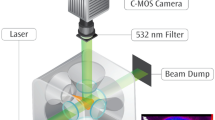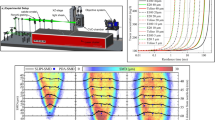Abstract
Evaporating Diesel sprays are studied by laser Rayleigh scattering measurements in an optically accessible high-pressure/high-temperature cell that reproduces the thermodynamic conditions which exist in the combustion chamber of a Diesel engine during injection. n-Decane is injected into the vessel using a state-of-the-art near-production three-hole nozzle. Global images of the distributions of the liquid and vapor phases of the injected fuel are obtained using a combined Schlieren and Mie scattering setup. More details about the evaporation are revealed when the spray is illuminated by a laser light sheet: laser light can be scattered by molecules in the gas phase (Rayleigh scattering) or comparably large fuel droplets (Mie scattering). The former is seen in regions where the fuel has completely evaporated, and the latter is dominant in regions with high droplet concentrations. Studying the polarization of the signal light allows the distinction of three different regions in the spray that are characterized by a moderate, low or negligible concentration of liquid fuel droplets. The characteristics of fuel evaporation are investigated for different observation times after the start of injection, chamber conditions and injection pressures. For the quantification of the fuel concentration measurements based on Rayleigh scattering, a calibration method that uses propane as a reference gas is presented and tested. At high ambient temperatures, the accuracy of the concentration measurements is limited by pyrolysis of the fuel molecules.














Similar content being viewed by others
References
Arndt S, Gartung K, Pauer T, Zeh D, Brüggemann D, Egermann J, Ipp W, Wagner V, Leipertz A (2000) Analysis of high pressure sprays for Diesel and SI engines with direct fuel injection: evaluation of evaporation and spray induced turbulence—Part II: spray evaporation and quantification of the local fuel air ratio inside the spray. In: Proceedings of ILASS-Europe 2000
Bittlinger G, Heinold O, Hertlein D, Kunz T, Weberbauer F (2003) Die Einspritzdüsenkonfiguration als Mittel zur gezielten Beeinflussung der motorischen Gemischbildung und Verbrennung. In: Proceedings of the 6th conference on engine combustion processes and modern techniques, HdT, pp 19–30
Bruneaux G (2005) Mixing process in high pressure Diesel jets by normalized laser induced exciplex fluorescence—Part I: free jet, SAE Technical Paper Series 2005-01-2100
Eckbreth AC (1988) Laser diagnostics for combustion temperature and species, 2nd edn, Combustion science and technology book series, vol 3, Gordon and Breach Publishers
Enderle C, Nolte A, Paule M, Duvinage F (2004) Der PKW im Spannungsfeld der Emissionsgesetzgebung, 2. Emission Control, Dresden
Espey C, Dec J, Litzinger T, Santavicca D (1997) Planar laser Rayleigh Scattering for quantitative vapor-fuel imaging in a diesel jet. Combust Flame 109:65–86
Gardiner WC, Hidaka Y, Tanzawa T (1981) Refractivity of combustion gases. Combust Flame 40:213–219
Harndorf H, Bittlinger G, Drewes V, Kunzi U (2002) Analysis of nozzle parameters and their influence on fuel mixture preparation in current and future diesel combustion systems. In: Proceedings of 5th international symposium on internal combustion diagnostics. AVL Deutschland GmbH
Idicheria CA, Pickett LM (2007) Quantitative mixing measurements in a vaporizing diesel spray by Rayleigh imaging, SAE Technical Paper Series 2007-01-0647
Khatchikian P, Harndorf H, Knopf M (2004) Dependence of the particle size distribution on the injection pressure of a modern diesel engine with a 1600 bar common-rail injection system. In: Proceedings of FISITA World Automotive Congress, Paper V027, 2004
Kim T, Ghandhi JB (2001) Quantitative 2-D fuel vapor concentration measurements in an evaporating diesel spray using the exciplex fluorescence method, SAE Technical Paper Series 2001-01-3495
Miles RB, Lempert WR, Forkey JM (2001) Laser Rayleigh scattering. Meas Sci Technol 12:R33–R51
Partington JR (1953) An advanced treatise on physical chemistry, vol IV. Physico-Chemical Optics, Longmans, Green, London
Pauer T, Wirth R, Brüggemann D (1999) Zeitaufgelöste Analyse der DI-Dieselgemischbildung mittels kombinierter Schlieren-/Streulichttechnik. In: Proceedings of 4th conference on engine combustion processes and modern techniques, HdT
Payri F, Pastor JV, Pastor JM, Julia JE (2006) Diesel spray analysis by means of planar laser-induced exciplex fluorescence. Int J Eng Res 7:77–89
Redlich O, Kwong JNS (1949) On the thermodynamics of solution. V-An equation of state. Chem Rev 44:233–244
Schulz C, Sick V (2005) Tracer-LIF diagnostics: quantitative measurement of fuel concentration, temperature and air/fuel ratio in practical combustion situations. Progr Energy Combust Sci 31:75–121
Schulz C, Gronki J, Andersson S (2004) Multi-species laser-based imaging measurements in a Diesel spray, SAE Technical Paper Series 2004-01-1917
Soave J (1972) Equilibrium constants from a modified Redlich–Kwong equation of state. Chem Eng Sci 27:1197–1203
Vogel AI (1946) Physical properties and chemical constitution of aliphatic hydrocarbons. J Chem Soc 9:133–142
Winter J, Dittus B, Kerst A, Muck O, Schulz R, Vogel A (2004) Nozzle hole geometry—a powerful instrument for advanced spray design. In: Proceedings of THIESEL Conference, Valencia
Zhao H, Ladommatos N (1998) Optical diagnostics for in-cylinder mixture formation measurements in IC engines. Progr Energy Combust Sci 24:297–336
Zhao Z, Li J, Kazakov A, Dryer FL, Zeppieri SP (2005) Burning velocities and a high temperature skeletal kinetic model for n-decane. Combust Sci Tech 177:89–106
Acknowledgments
The pyrolysis of n-decane was simulated by Mustapha Fikri from IVG, University of Duisburg-Essen. His support is greatly appreciated.
Author information
Authors and Affiliations
Corresponding author
Rights and permissions
About this article
Cite this article
Adam, A., Leick, P., Bittlinger, G. et al. Visualization of the evaporation of a diesel spray using combined Mie and Rayleigh scattering techniques. Exp Fluids 47, 439–449 (2009). https://doi.org/10.1007/s00348-009-0673-y
Received:
Revised:
Accepted:
Published:
Issue Date:
DOI: https://doi.org/10.1007/s00348-009-0673-y




